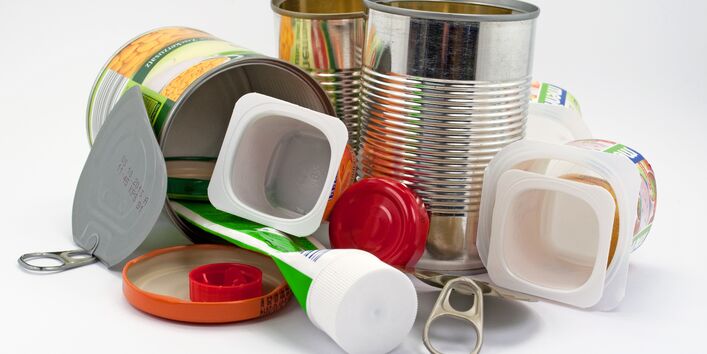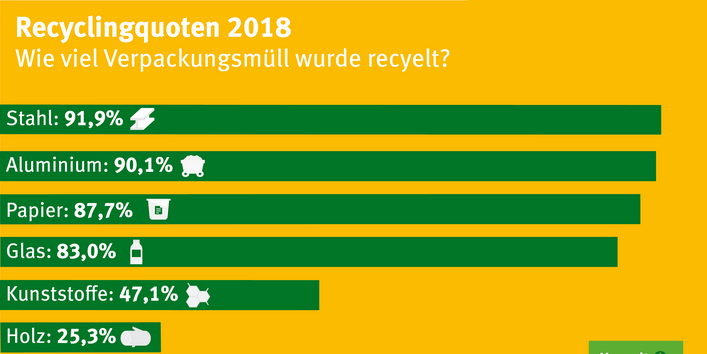Further increase in packaging consumption in 2018 in Germany
In 2018, Germany generated a total of 18.9 million tonnes of packaging waste. This is 0.7 per cent more than in 2017 and corresponds to an average of 227.5 kg of packaging waste per capita. Since 2010, packaging consumption has thus increased by 17.9 percent. This is shown in the latest report by the German Environment Agency (UBA) on the volume and recycling of packaging in Germany. Private final consumers account for 47 percent of the total quantity, i.e. over 8.9 million tonnes or 107.7 kg per capita. This is one percent more than the previous year and 20.6 percent more than in 2010. Dirk Messner, President of UBA, said, "Packaging should be avoided before it is even produced. Returnable cups, for example for coffee "to go", must become the rule, but anyone taking food to go should also be able to do so in reusable containers. This would put an end to the flood of pizza boxes and coffee cups in rubbish bins and parks."
Even though Germany continues to be one of the pioneers in the recycling of packaging, there is still room for improvement: 69 percent of the total packaging waste volume was recycled, while the remainder was largely recovered for energy purposes. The recycling rate varies for the different materials. It is comparatively high for glass (83%), paper/cardboard (87.7%), steel (91.9%) and aluminium (90.1%). However, there is still much potential for recycling plastics (47.1%) and wood (25.3%). Mr Messner said, "As a rule, recycling is the best way to recover packaging waste. This is why the recyclability of packaging and the use of recycled materials are also decisive aspects of a circular economy. We must return to rising recycling rates." From 2019, the new Packaging Act will enter into force, requiring among others higher recycling rates from the dual systems. The recycling rate for plastic packaging has remained at 58.5 per cent since 2019, and will rise to 63 per cent in 2022. In addition, the dual systems must now take into account the recyclability of packaging and the use of recycled materials in their compliance fees.
There are various reasons for high packaging consumption. A major driver is economic growth, because more products on the market also leads to more packaging. The effects of the coronavirus pandemic on packaging consumption are not yet clear. However, due to the closure of shops and restaurants, it is likely that more service packaging was used, especially for food and beverages.
Consumer habits are also responsible for more packaging waste. One example is the trend in non-returnable packaging towards resealable packaging, dosing aids and generally more elaborate seals. While these functions can help to conserve resources through targeted dosing or by avoiding food waste, they also help to reduce the amount of waste. However, additional functions are often associated with increasing material consumption. Mr Messner said, "Producers should reduce the environmental impact of packaging by eliminating unnecessary functions and using reusable packaging. Packaging should be designed as simply as possible, not least so that it can be recycled more easily. It is best to use immediately recycled raw materials for production."
The trends towards smaller portion packaging and online shopping has also continued. The trend to consume take-away food and beverages on the go, at work or at home also continued in 2018.
For manufacturers of packaging which typically accumulates as waste from private final consumers, a minimum standard for the assessment of recyclability published by the Central Packaging Register and UBA provides important guidance on how packaging can be designed in an environmentally friendly manner. On the basis of this standard, packaging manufacturers can determine and optimise the recyclability of their packaging.
Further information:
The following types of packaging account for total consumption: sales, secondary, transport, reusable, and packaging with harmful fillers and one-way components in reusable packaging. The recycling rates for total accrual are based on all the packaging waste accrued in Germany which is recycled domestically or in another country. These rates are distinct from the rates stipulated in the Packaging Act, which must as a minimum be achieved by the dual systems. This includes commercial packaging of goods which typically accrues as waste with private final consumers after use. The recycling quotas in the Packaging Act are not determined based on accrual of packaging waste, but rather on amounts participating in the dual systems and the amount of lightweight packaging collected. Information on compliance with these quotas will be published separately at a later date.
The guidelines of the European Packaging Directive applicable for the 2018 reporting year are determined based on the amounts of waste delivered to recycling installations, most fractions of which are sorted according to material at a sorting installation. However, plastic packaging in particular is often contaminated and the upstream processes of recycling incur further waste fractions that are not recycled. The actual proportion of recycled packaging is therefore lower. Calculation methods will be adjusted in order to collect data pursuant to the changed requirements of the EU Packaging Directive. By the time of reporting year 2020 at the latest, determination of the recycling quota will focus on the amounts fed into the final recycling process. Data for the year 2019 is expected to be published in September 2021.






